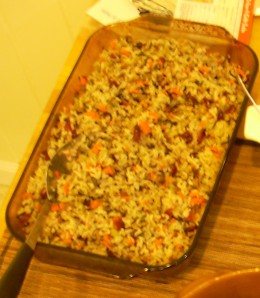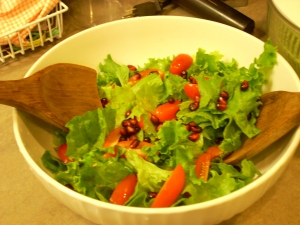I’ts no surprise that Thanksgiving is a foodie’s Superbowl, that a November issue of Cooking Light is equivalent to the September issue of Vogue, that a little too much planning goes into the day. Well, darn it, it should be. The singular activity designated for this holiday is to eat a ridiculously big meal with family. Everyone expects it to be special, and that’s where we come in.  I voluntarily made most of this meal, mainly to prove to myself that I could, but also to prove that a Thanksgiving plate doesn’t have to weigh you down–the classics can be updated and paired smartly so it still looks like a holiday, but doesn’t turn you into a parade float. Case in point, the “stuffing”…
I voluntarily made most of this meal, mainly to prove to myself that I could, but also to prove that a Thanksgiving plate doesn’t have to weigh you down–the classics can be updated and paired smartly so it still looks like a holiday, but doesn’t turn you into a parade float. Case in point, the “stuffing”…
Wild Rice Dressing with Roasted Chestnuts and Cranberries. Definitely not a Stouffer’s or cornbread and sausage affair, but so good. The rice was nutty and fragrant, a little sauteed carrot, onion, and celery with herbs (sage, parsley, thyme) added freshness, roasted chestnuts gave earthiness (just open the can and roast on a sheet pan for a few minutes), and rehydrated dried cranberries gave a little tart, sweet pop. It didn’t overwhelm the other dishes, and reheated like a dream with a little chicken broth (doesn’t regular stuffing just sog after awhile?) Labor intensive? Well, yeah. But you’re allowed to take that time. That’s what the day is for. And the results are worth it. 
Brussels Sprouts with Garlic and Shallots. I nixed the bacon from the recipe, using olive oil instead of drippings. Just a little sliced garlic and shallots elevated the flavor subtly, a little broth at the end let them steam a little after caramelizing to just the right doneness. If you’re not a fan in general, I might not convert you. But if you’re not a fan because you’ve only had the shriveled, boiled lumps from a can, I dare you to wrinkle your nose at these.
Fresh salad. Just greens, tomatoes, pomegranate aerils. I didn’t make a vinaigrette, figuring you could blend the items on the plate without having one oily, tangy dressing cover all. A fresh, clean note is always welcome–like cleansing the palette in between bites.
Butternut squash with almonds. Joan brought this dish and it was a perfect accompaniment. I’d say some kind of root veg or hearty squash is essential for the day, and butternut squash have such great flavor. The starch content is also a bit lower than potatoes, so you won’t feel like a sack of bricks when you try to get up from the table. Really delicious. 
Cranberry Orange relish. I know the photo looks dubious, but this is so good. Just pulse up a bag of fresh cranberries, a cut up navel orange (peel and all), 1/2 to 3/4 cup sugar, a teaspoon or two of cinnamon. A cool, bright, tart note to contrast the chicken, excellent for breakfast the next day. I never understood the jellied stuff or a syrupy, candied version that’s been boiled like jam. Contrast the hot with the cool, the cooked with the fresh. It keeps your mouth busy. 
Did I say chicken? Yeah, I did. We decided early on to forgo the big bird, in favor of something that would cook in half the time and serve 5 people much more adequately. Chickens are easier: to keep moist, to truss, to carve. I’d love to take on the turkey challenge next year, though. These guys weren’t an afterthought, however. These are Bell and Evans organic chickens, with a spiced butter rubbed under the skin, a Classic Roast Chicken with a bit more glamour.  Pies. This is a tradition I just can’t argue with. I did shortcut with refrigerated pie crusts, but I did crimp the edges in a pie plate instead of using a frozen shell. Karen made the pumpkin filling. A little trick for the apple–I cut 4 farmer’s market Granny Smith’s into thin wedges, not chunks, then tossed with 1/2 cup sugar, 1 teaspoon cinnamon, 1/4 teaspoon allspice, 2 tablespoons cornstarch, 11/2 tablespoons lemon juice, and didn’t overfill the crust. Brush the top with an egg white and cut an X on top. This time, no giant gap between crust and apples–just a perfect pie. I made some whipped cream by beating heavy cream with a little sugar. Unnecessary, but wonderful.
Pies. This is a tradition I just can’t argue with. I did shortcut with refrigerated pie crusts, but I did crimp the edges in a pie plate instead of using a frozen shell. Karen made the pumpkin filling. A little trick for the apple–I cut 4 farmer’s market Granny Smith’s into thin wedges, not chunks, then tossed with 1/2 cup sugar, 1 teaspoon cinnamon, 1/4 teaspoon allspice, 2 tablespoons cornstarch, 11/2 tablespoons lemon juice, and didn’t overfill the crust. Brush the top with an egg white and cut an X on top. This time, no giant gap between crust and apples–just a perfect pie. I made some whipped cream by beating heavy cream with a little sugar. Unnecessary, but wonderful.
So, yes, a lot of cooking, but so much fun and so worth it. Planning, patience, a sharp knife, great people to feed, and a nice red wine to finish the day. Maybe this culinary training is starting to pay off a little?





